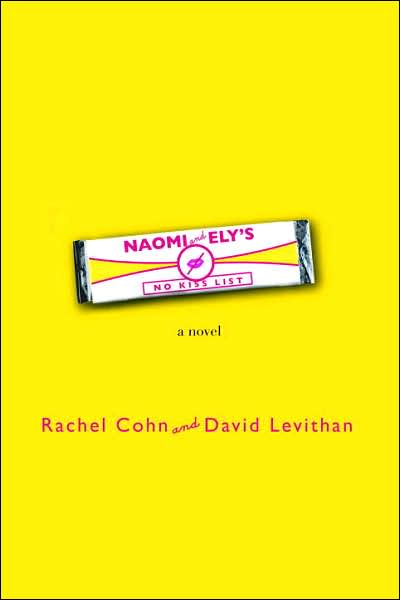Naomi and Ely's No-Kiss List, by David Leviathan and Rachel Cohn
Jun 4
2008

David Levithan writes about teenagers so well that I originally thought he must not be too far divorced from his own teen years. As it turns out, he’s thirty-eight—but his writing does an excellent job of conveying the confidence and self-assurance of kids hovering on the cusp of adulthood, as well as their naïveté.
Extended adolescence is the central motif in both the novel Naomi and Ely’s No Kiss List, which was co-written with Cupcake author Rachel Cohn, and the short-story collection How They Met. Leviathan’s characters are mostly above the age of consent, often gay, occasionally drunk, usually big-city kids. They also carry a lot of freight: youth, sexuality, gender roles, parental divorce, starting college. Throughout, Mr. Levithan manages to write their stories in a simple, straight-forward fashion.
Both books are sprints of perspective. I expected this from How They Met, a collection of 18 short stories written over several years, but it is also true of Naomi and Ely’s No Kiss List, which channels seven different teenagers over two hundred and twenty pages. Team writing helps here, and not only with the different gender perspectives. Rachel Cohn breathes levity and diversity into Naomi and Ely without seriously changing the tone of How They Met. Despite the authors’ juggling act, each of the characters has a distinct voice and defining symbols. Literally, in Naomi’s case—she thinks in Wingdings. At first this quirk was a little annoying, but it became very effective as the book progressed. More than a simple affectation, it became Naomi. Many of the other characters took such simple, often obvious, starting points and developed into fully dimensional people.
 Leviathan and Cohn manage all of these stories and personalities almost without dialogue. Even the small-talk is presented in summarized, recollected form rather than the word-for-word transcripts of other novels. The style allows the characters to develop themselves through rich internal monologues—think Claire Danes’s character in My So-Called Life. Characters burn with self-absorbed curiosity about the minutiae of relationships: What significance a kiss? How many subtleties in a text message?
Leviathan and Cohn manage all of these stories and personalities almost without dialogue. Even the small-talk is presented in summarized, recollected form rather than the word-for-word transcripts of other novels. The style allows the characters to develop themselves through rich internal monologues—think Claire Danes’s character in My So-Called Life. Characters burn with self-absorbed curiosity about the minutiae of relationships: What significance a kiss? How many subtleties in a text message?
Eventually, the magic of reliving my teen years wore thin. Writers are like balloon artists: they start with flat, formless items, breathe into them until they become people, and twist them into a variety of (hopefully fascinating and original) shapes. Mr. Levithan has a remarkable gift for breathing life into his teenage creations, but his balloon-twisting skills are limited.
[Review by the noble and selfless Keith]
Extended adolescence is the central motif in both the novel Naomi and Ely’s No Kiss List, which was co-written with Cupcake author Rachel Cohn, and the short-story collection How They Met. Leviathan’s characters are mostly above the age of consent, often gay, occasionally drunk, usually big-city kids. They also carry a lot of freight: youth, sexuality, gender roles, parental divorce, starting college. Throughout, Mr. Levithan manages to write their stories in a simple, straight-forward fashion.
Both books are sprints of perspective. I expected this from How They Met, a collection of 18 short stories written over several years, but it is also true of Naomi and Ely’s No Kiss List, which channels seven different teenagers over two hundred and twenty pages. Team writing helps here, and not only with the different gender perspectives. Rachel Cohn breathes levity and diversity into Naomi and Ely without seriously changing the tone of How They Met. Despite the authors’ juggling act, each of the characters has a distinct voice and defining symbols. Literally, in Naomi’s case—she thinks in Wingdings. At first this quirk was a little annoying, but it became very effective as the book progressed. More than a simple affectation, it became Naomi. Many of the other characters took such simple, often obvious, starting points and developed into fully dimensional people.
 Leviathan and Cohn manage all of these stories and personalities almost without dialogue. Even the small-talk is presented in summarized, recollected form rather than the word-for-word transcripts of other novels. The style allows the characters to develop themselves through rich internal monologues—think Claire Danes’s character in My So-Called Life. Characters burn with self-absorbed curiosity about the minutiae of relationships: What significance a kiss? How many subtleties in a text message?
Leviathan and Cohn manage all of these stories and personalities almost without dialogue. Even the small-talk is presented in summarized, recollected form rather than the word-for-word transcripts of other novels. The style allows the characters to develop themselves through rich internal monologues—think Claire Danes’s character in My So-Called Life. Characters burn with self-absorbed curiosity about the minutiae of relationships: What significance a kiss? How many subtleties in a text message?Eventually, the magic of reliving my teen years wore thin. Writers are like balloon artists: they start with flat, formless items, breathe into them until they become people, and twist them into a variety of (hopefully fascinating and original) shapes. Mr. Levithan has a remarkable gift for breathing life into his teenage creations, but his balloon-twisting skills are limited.
[Review by the noble and selfless Keith]
Posted by: Julianka
No new comments are allowed on this post.
Comments
No comments yet. Be the first!